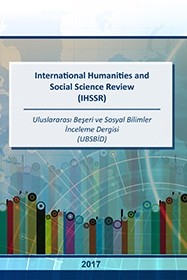PEDAGOJİK İÇERİK BİLGİSİNE SAHİP ÖĞRENCİ ÖĞRETMENLERİN ÖĞRETİM KOŞULLARINDA MULTİMEDYA TEKNOLOJİSİNİN YERİ
Amaç: Multimedya teknolojilerinin multimedya ekranlarındaki rolünü, öğrenci öğretmenlerinpedagojik içerik bilgisini, ders kitaplarını ve çalışma sayfalarının müfredatını içeren gelenekselöğretime kıyasla arttırmaktır.Tasarım/Yöntem: Üçgenleme araştırması tasarımı kullanılmıştır, çünkü çalışmanın hem nitelhem de nicel analizi yapılmıştır. Bu çalışma için veri toplama araçları, bir akıllı tahta, ikiprojektör, akademik başarı testleri, mülakatlar, gözlemler ve anketlerdir.Sonuçlar: Multimedya teknolojisinin çoklu ekranlar ile kullanılması konusundaki olumluperspektifleri, ders kitaplarının geleneksel kullanımı ile kıyaslandığında yansıtabileceğidüşünülmektedir,Özgün değer: Çoklu ortam teknolojisi, öğretmen adaylarının düşünme, analiz etme, akılyürütme ve öz-farkındalık becerilerini geliştirmede çok etkili olacağından, gelecekte yapılmakistenen çok sayıda çalışmaya, temel teşkil edecektir.
Anahtar Kelimeler:
Multimedya Teknolojisi, Multimedya Ekranları, Öğrenci Öğretmenleri, İkinci Dil Öğretmenliği Eğitimi
THE IMPACT OF MULTIMEDIA TECHNOLOGY ON BOOSTING STUDENT TEACHERS’ PEDAGOGICAL CONTENT KNOWLEDGE COMPARED TO TRADITIONAL TEACHING
Objectives: The purpose of this research is to find out the role of multimedia technology withmultimedia screens in terms of boosting student teachers’ pedagogical content knowledgecompared to traditional teaching which includes the curriculum of course books and worksheets.Methods: The triangulation research design was used in this study because there were bothqualitative and quantitative analysis of the study. The data collection tools for this study werea smart board, two projectors, academic achievement tests, interviews, observations andquestionnaires.Results: This research which reflects the positive perspectives about the use of the multimediatechnology with multi-screens compared to the traditional usage of course books.Originality: Since multimedia technology will be very effective in developing pre-serviceteachers' thinking, analyzing, reasoning and self-awareness skills, it will be the basis for manyfuture studies.
Keywords:
Multimedia Technology, Multimedia Screens, Student Teachers, Second language teacher education (SLTE),
___
- Baş, G., & Beyhan, Ö. (2010). Effects of multiple intelligences supported project-based learning on students’ achievement levels and attitudes towards English lesson. International Electronic Journal of Elementary Education, 2(3), 365-385.
- Beichner, R. J. (1994). Multimedia editing to promote science learning. Journal of Educational Multimedia and Hypermedia, 3(1), 55-70.
- Bitner, N., & Bitner, J. (2002). Integrating technology into the classroom: Eight keys to success. Journal of technology and teacher education, 10(1), 95-100.
- Bruce, B. C., & Hogan, M. P. (1998). The disappearance of technology: Toward an ecological model of literacy. Handbook of literacy and technology: Transformations in a post- typographic world (pp. 269-281). Hillsdale, NJ: Erlbaum.
- Callaway, J. A. (1996). An interactive multimedia computer package on photosynthesis for high school students based on a matrix of cognitive and learning styles. Columbia University Teachers College.
- Cuaresma, J. (2008). Learning style preferences and academic performance of PHEM majors at the University of the Cordilleras. Unpublished Undergraduate Thesis. University of the Cordilleras, Baguio City.
- Dale, E. (1946, 1954, 1969). Audio-visual methods in teaching. New York: Dryden.
- DiCicco-Bloom, B., & Crabtree, B. F. (2006). The qualitative research interview. Medical education, 40(4), 314-321.
- Ertmer, P. A. (2005). Teacher pedagogical beliefs: The final frontier in our quest fortechnology integration. Educational Technology, Research and Development, 53(4), 25-39.
- Fabrigar, L. R., Wegener, D. T., MacCallum, R. C., & Strahan, E. J. (1999). Evaluating the use of exploratory factor analysis in psychological research. Psychological methods, 4(3), 272.
- Graddol, David, (1997). The Future of English? A Guide to Forecasting the Popularity of the English Language in the 21st Century, London, British Council.
- Holec,H.(1981). Autonomy and Foreign language learning. Oxford: Pergamon.
- Jack. R Fraenkel, & Wallen, N. E. (2006). How to design and evaluate research in education. McGraw-Hill.
- Joshi, A. (2012).Multimedia: A Technique in Teaching Process in the classrooms. Current World Environment, 7(1), 33-36.
- Kasper, L. F. (1997). The impact of content-based instructional programs on the academic progress of ESL students. English for specific purposes, 16(4), 309 320.
- Koehler, M., & Mishra, P. (2009). What is technological pedagogical content knowledge (TPACK)? Contemporary issues in technology and teacher education, 9(1), 60-70.
- Kramsch, C. (1999). Teaching Text and Context through Multimedia. Language Learning & Technology 2 (2), pp.31-41.
- Mao, M. L. (2010). A study on the problems and their countermeasures of multimedia teaching of college English. Computer-Assisted Education Study, 68-70.
- Motteram, G. (2013). Innovations in learning technologies for English language teaching.
- Norman K. Denzin, & Yvonna S. Lincoln. (2005). The Sage handbook of qualitative research. Sage.Office of Technology Assessment (OTA) (1995). Teachers & technology: Making the connection. Washington, DC: U.S.
- Office of Technology Assessment (OTA) (1988). Power on! New tools for teaching and learning. Washington, DC: U.S.
- Peachy, N. (2008). Designing and writing questionnaires. British Council: English Online: TEACHERS, Retrieved from: http://www.englishonline.org.cn./en/ teachers/action-research-toolkit/questionnaires.
- Pun, M. (2014). The Use of Multimedia Technology in English Language Teaching: A Global Perspective. Crossing the Border: International Journal of Interdisciplinary Studies, 1(1), 29-38.
- Shen, C. F., & Cheng, D. Y. (2008). Characteristics and Principles in Network and Multimedia-based Foreign Language Instruction [J]. Computer-Assisted Foreign Language Education in China, 3.
- Shulman, L. (1986). Those who understand: Knowledge growth in teaching. Educational Researcher, 15(2), 4-14.
- Simon, H. (1969). Sciences of the artificial. Cambridge, MA: MIT Press.
- Valli, K. Sunthara & Priya, Dr. N.S.Vishnu (2016). Use of Multimedia in English Language Teaching, Department of English, School of Social Sciences & Languages VIT University, Vellore, India.
- Zhang (2006). The development tendency of the modern foreign language teaching and the computer assisted instruction.
- Başlangıç: 2017
- Yayıncı: Derya SEMİZ ÇELİK
